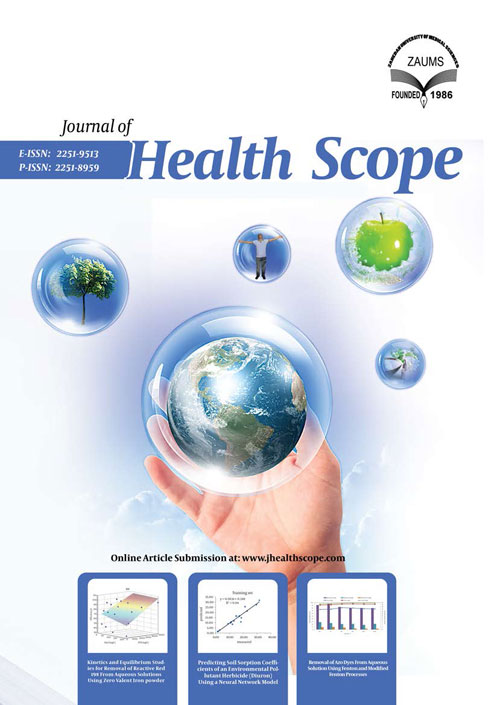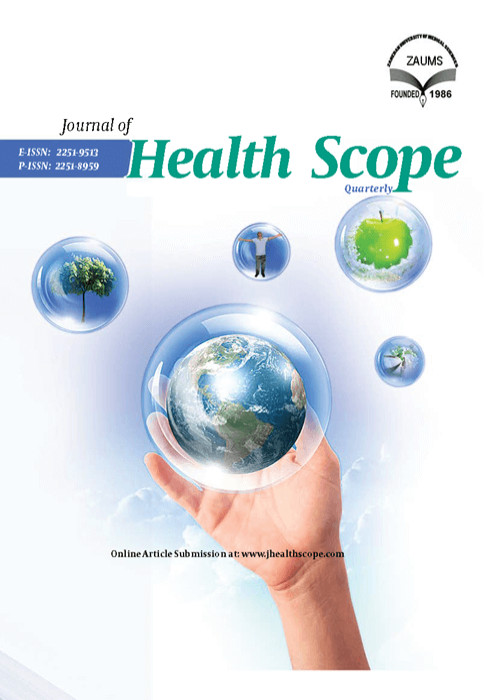فهرست مطالب

Journal of Health Scope
Volume:5 Issue: 1, Feb 2016
- تاریخ انتشار: 1394/10/25
- تعداد عناوین: 10
-
-
Page 5BackgroundComposting process is a feasible biological treatment for the recycling of municipal solid wastes as a soil amendment. The principal requirement of compost for it to be safely used in soil is a high degree of stability or maturity, which implies stable organic matter content as well as the absence of phytotoxic compounds and plant or animal pathogens..ObjectivesAt the present study, the maturity and stability of composted municipal solid wastes at a biocompost plant was evaluated..Materials And MethodsFor the assessment of compost maturity, important parameters including temperature, moisture content, pH, electrical conductivity, carbon-to-nitrogen (C/N) ratio, microbial parameters including Salmonella, total and fecal coliforms were measured during the composting process (80 days). In addition, phytotoxicity as seed germination index and heavy metals concentration (Zn, Cu, Cr, Ni, Cd and Pb) was determined at the end of the composting time..ResultsThe results showed that the C/N ratio decreased during the composting process (reached to 15.6) due to the loss of carbon and the increase in nitrogen content per unit material; also, the NH4+/NO3 ratio decreased with increase in the time of composting and reached to 1.08. In addition, the microbial parameters including Salmonella and total and fecal coliforms decreased significantly at the end of the composting period and reached to standard values. Furthermore, germination index (GI) increased during the composting process and the compost samples at the end of the composting phase had GI values greater than 90..ConclusionsThe produced compost in this study was mature and ready for use as an agricultural substrate or soil conditioner after 80 days of composting..Keywords: Solid Waste, Maturity, Heavy Metals, Salmonella
-
Page 6BackgroundFungi are regarded as one of causal factors of respiratory allergies and are a serious threat to public health in indoor environments. Before conclusively identifying fungi as the major causative agent of all or some types of rhinitis, we should have a good knowledge of the fungal flora of the nasal cavity and indoor building environments of healthy subjects..ObjectivesThe aim of this study was to determine the presence and relative abundance of fungal flora in the nasal cavity and bedroom of healthy subjects in Mashhad city, north east of Iran..Patients andMethodsA group of fifty healthy volunteers without a history of respiratory system diseases were selected. Samples from the nasal cavity and different parts of the bedroom including indoor air, pillow, mattress, blanket, dust of the bed, dust of the shelf and dust of the air duct were collected and cultured. The fungi were identified by standard mycological techniques..ResultsThe most common fungi isolated from all samples were Aspergillus, Penicillium, Yeast, Alternaria and Cladosporium. Stemphylium, Ulocladium, Stachybotrys, Basidiobolus and Exophiala showed the least frequencies among the isolated fungi..ConclusionsThe presence of fungi in the nasal cavity and indoors of healthy subjects in this study suggests that fungi should be considered as health hazards. Furthermore, it is important and seems necessary to monitor indoor air quality and raise awareness of existing threats due to microorganisms, including fungi..Keywords: Nasal Cavity, Healthy Volunteers, Air Pollution, Indoor, Fungi
-
Page 8BackgroundHigh concentrations of natural organic matter (NOM) may cause the production of harmful compounds in treated drinking water. Surfactant-modified zeolites (SMZs) with various loadings of sodium dodecyl sulfate (SDS) have been used as adsorbents to remove NOM from aqueous solution. SMZ has presented higher NOM adsorption more efficiency than natural zeolite. NOM affects the quality of drinking water in several points..ObjectivesThe purpose this study was to investigate the SDS-modified isotherm of natural Iranian zeolite obtained from Semnan mines, for the removal of NOM from aqueous solution..Materials And MethodsThe adsorption of NOM onto SDS-modified zeolite as a function of contact time, initial NOM concentrations, adsorbent dose and solution pH was investigated. The isotherm experiments were carried out with fixing the adsorbent dose and varying the initial concentration of NOM..ResultsThe results indicated that SDS-modified zeolite showed greatly enhanced adsorption capacity. Findings revealed that the Langmuir isotherm best described the NOM adsorption on the adsorbent. The adsorption isotherm was well fitted to the Langmuir model. The maximum adsorption capacity of SMZ with surfactant bilayer coverage for NOM was 111 mg/g at 25°C and pH = 5..ConclusionsThe findings of this study showed that the modification of natural zeolites can achieve higher adsorption capacity for organics. In addition, based on the results, natural zeolite being modified with SDS as a cationic surfactant had good efficiency for the adsorption of NOM..Keywords: Natural Organic Matter, Modified Zeolites, Sodium Dodecyl Sulfate, Adsorption
-
Page 9BackgroundCoronary artery disease (CAD) is a common cause of death and disability, with the mortality incidence of 167 per 100,000 people. The Known physical cause of coronary heart disease (CHD) can predict only 50% of CHD incidence. Recently, health psychologists pay attention to the key role of nonbiological factors such as psychological factors in CHD..ObjectivesThe aim of this study was to examine the direct and indirect relationships between type D personality and quality of life in CHD patients and create a conceptual model..Patients andMethodsIn this cross- sectional study, 99 CAD patients were finally selected from the patients referred to the angiography unit of Mostafa- KHomeini Hospital in Tehran, Iran, from April to June 2012. The questionnaires used to gather data were type D personality scale, quality of life scale and illness perception scale. To design the model, we used analysis of Moment Structures (AMOS) software because the suggested model was a kind of structural equation models..ResultsNinety-nine CHD patients, with the mean age of 59.7 years (age range, 20 - 86) were studied and 58.8% of them were males. Cronbach’s alpha for quality of life and type D personality questionnaires were calculated 0.93 and 0.81, respectively. Forty-eight significant parameters estimated in the model that is fitted with the chi-square = 67.905, degrees of freedom = 57 and P-value = 0.153. The type D personality was related to quality of life in patients with CHD directly or indirectly by a mediator of the perception of illness..ConclusionsDiagnosing type D personality and knowing about the effect of these perceptions can help physician to identify patients with prone personality and prevent them from the disease by changing their lifestyle..Keywords: Coronary Artery Disease_Type D Personality_Risk Factors_Models_Structural Equation Modeling
-
Page 10BackgroundPapads are cereal or legume based preserved products rich in proteins. They are consumed after deep fat frying as a side dish in India. In the present work, the traditional savoury was chosen for value addition with green leafy vegetables i.e., purslane leaves. Legume based papads were prepared using black gram and purslane leaves with different amounts (10%, 15%, 20%, 25%, and 30%)..ObjectivesThe present study was conducted to develop value added traditional savoury with green leafy vegetables (purslane)..Materials And MethodsPhysical and chemical analyses of the raw papads were carried out according to the Association of Analytical Communities (AOAC) methods. The fried papads were tested for oil uptake and also, subjected to sensory evaluation by semi-trained panelists..ResultsAll the chemical constituents like moisture content, ash content, pH, alkalinity, acid insoluble ash of all the different amounts were on par with the control, whereas ß-carotene content and crude fiber which were calculated theoretically increased as the percentage of incorporated green leafy vegetables increased. All the samples subjected for sensory evaluation were accepted equally by the panelists. Micronutrients, vitamins, and dietary fiber contents of green leafy vegetable papads increased remarkably..ConclusionsThis work gained satisfactory results in developing a nutritionally fortified and palatably accepted papads using purslane leaves..Keywords: Papads Micronutrients, Dietary Fiber
-
Page 11BackgroundThe presence of excess ammonia nitrogen in aqueous environments has caused various problems such as eutrophication, oxygen depletion and aquatic toxicity. Hence, it is necessary to have special consideration in the discharge of ammonia to environment.ObjectivesThe aim of this study was to study kinetic of ammonia degasification at a short-time (6 hours) with relatively constant pH and temperature.Materials and MethodsAmmonia degassing was carried out using a diffused air stripper. The unit consisted of 1 L cylindrical column with dimension of 30 × 8 cm. The flow rate was set at 2 L/minute at 6 hours. The operating parameters such as ammonia, nitrate, nitrite, electrical conductivity (EC), the oxidation-reduction potential (ORP), and pH were analyzed according to standard methods.ResultsAccording to obtained results, the maximum removal efficiencies were determined 17%, 35.5%, 31%, 66%, and 85.5%, for 50, 100, 200, 500 and 1000 mg/L ammonia concentrations, respectively. A first-order kinetic model was adopted to represent the ammonia degassing.ConclusionsThe ammonia degassing is a simple and suitable technology for ammonia removal at high concentration. Undesirable removal efficiency (17%, 35.5% and 31%) can be occurred in suitable pH 11 in the presence of lower ammonia concentrations (50, 100 and 200 mg/L).Keywords: Ammonia, Wastewater, Removal, Environment Kinetics


